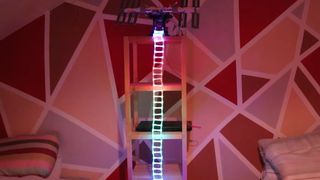
When it comes to Raspberry Pi projects, makers sure know how to go the distance. However, it’s Element 14’s Lorraine who was given an inch and took a mile with her latest creation. In a video recently released to Element 14’s YouTube channel, she’s unveiled plans to work together with her family to run to the International Space Station (ISS).
We know what you’re thinking, there’s no way you can run through outer space. In this case, the family is running here on Earth and using a Pi to log the collective distance. The data is processed by the Pico which illuminates an LED ladder to represent their progress toward reaching the ISS. The farther they run, the closer they get to reaching their goal.


The data used in the project is pulled from a tool called Strava. This is a website that has an accompanying mobile app that users can use to track their runs, bicycling routes and more. It lets you log not only how far you’ve gone but where you’ve been. Strava has an API that Lorraine is using to pull data from for the Pico to use in tracking their progress.
If you want to recreate this project or design something similar, you’ll need a little bit of hardware. In this case, Lorraine is using a Raspberry Pi Pico W which has access to the internet—necessary for updating the LEDs with data from Strava. The project also requires a strip of individually addressable LEDs. These will need to be modified into a ladder configuration to suit the project design.
As we said earlier, the project relies on Strava’s API. The family members each have their own profile. The data for each family member is individually processed so the ladder can represent their individual progress with a specific color. This makes it easy to see how far they’ve run and who is responsible for the most (or least) distance. Lorraine breaks down the code and how everything works in the video shared to Element 14’s channel.
To get a closer look at this Raspberry Pi project, we highly recommend checking out the original video shared to YouTube. There you can not only see how it works but get an idea of what it’s like in action.
Stay On the Cutting Edge: Get the Tom's Hardware Newsletter
Get Tom's Hardware's best news and in-depth reviews, straight to your inbox.

Ash Hill is a Freelance News and Features Writer with a wealth of experience in the hobby electronics, 3D printing and PCs. She manages the Pi projects of the month and much of our daily Raspberry Pi reporting while also finding the best coupons and deals on all tech.
Most Popular



